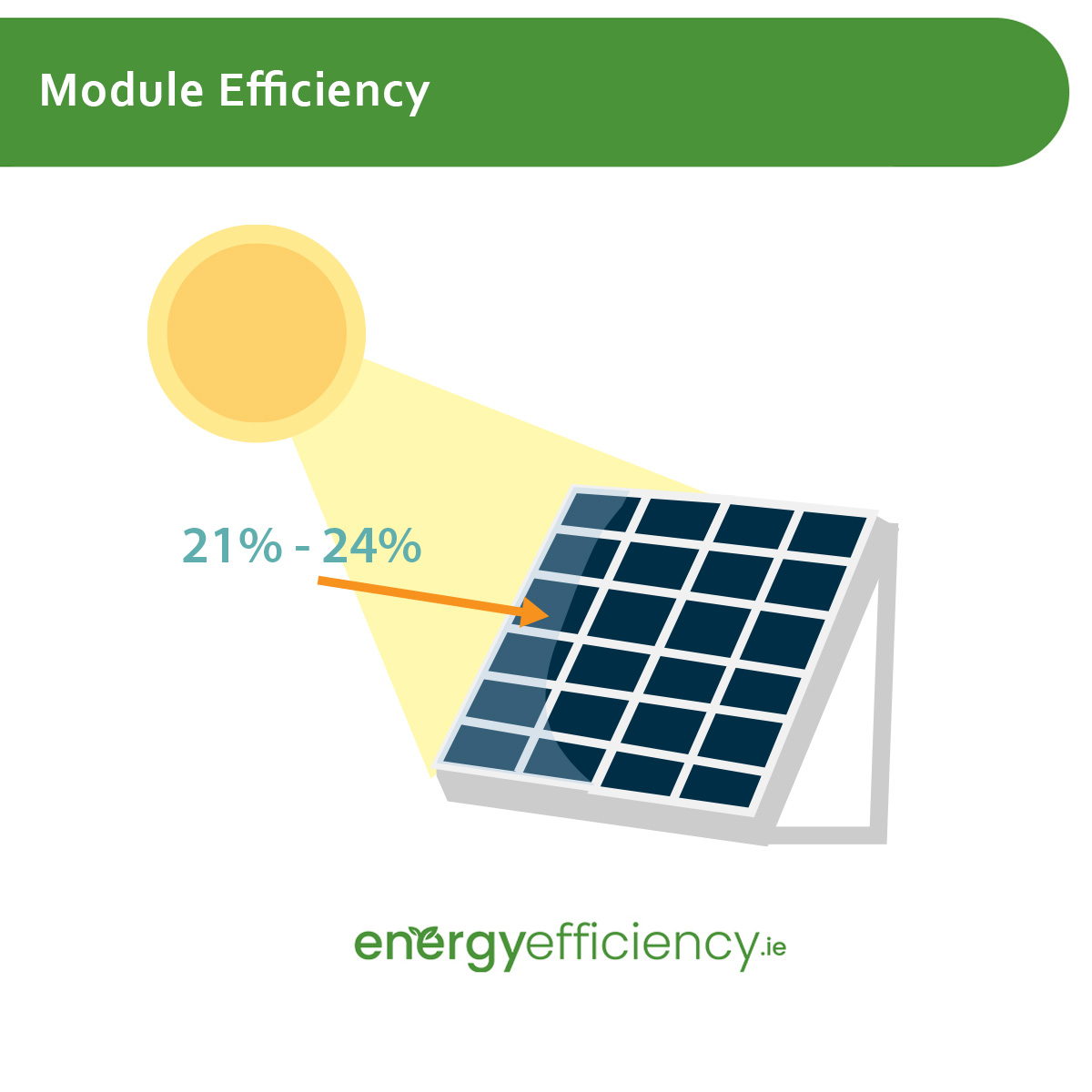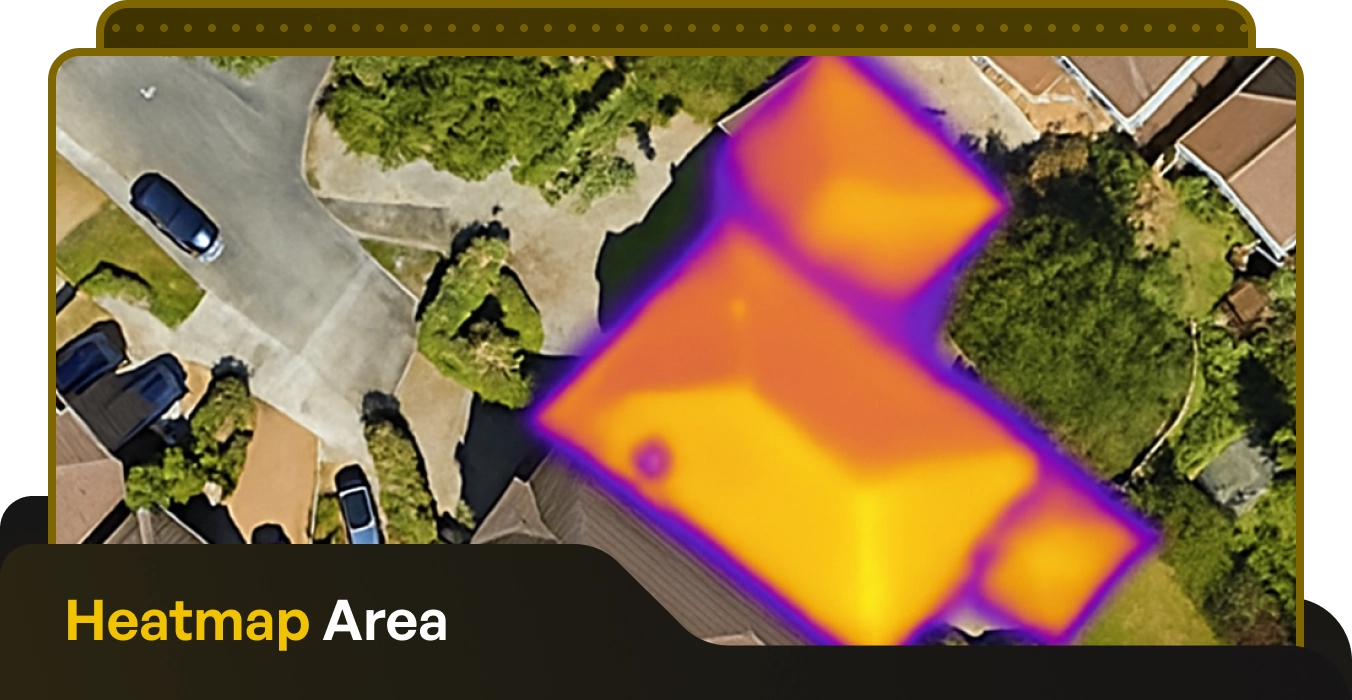Understanding Solar Panel Specifications

Written by: Briain Kelly
Published: July 4, 2024
Last updated: November 18, 2025
Reading time: 4 mins
Solar Panels come with a lot of information about their performance, durability, and electrical specifications which are extremely important for ensuring that your solar PV array is compatible with the home or business it’s attached to.
These data sheets, while beyond useful for installers, contain a lot of technical jargon which can be difficult to understand for others at best.
We want to break down a lot of the terms you will see used to describe different aspects of solar panels when getting technical.
Module Efficiency (%)
The module efficiency of a solar panel, is the measurement of how well it converts light into electricity. The higher the solar panel efficiency is, the more juice you get from the panel.
The best solar panels used for homes and businesses currently have efficiency ranges of 21% – 24%, and you should look for something in that range.

Test Conditions
Solar panels are tested under a variety of conditions to tell you what their performance is based on the strength of the sunlight, temperature, and other environmental factors.
The values used under standard test conditions are air mass 1.5 AM, Irradiance 1000 W/m², and a cell temperature of 25°C.
Standard Test Conditions (STC)
Standard Test Conditions are a set of universal criteria used to test solar panels which determines the values given for all the other fields on the data sheet governing their performance.
The values used under standard test conditions are air mass 1.5 AM, Irradiance 1000 W/m², and a cell temperature of 25°C.
Normal Operating Cell Temperature (NOCT)
The real world conditions in which solar panels will operate rarely match the standard test conditions, which gives a distorted view of what you can actually expect from a solar panel.
The NOCT is a measurement of the temperature the cells of a solar panel will reach under certain environmental conditions. This can be used to give a better measurement of how a panel’s performance might compare with STCs.
The environmental settings used to calculate the NOCT of a solar panel are:
- Irradiance: 800 W/m²
- Air temperature: 20℃
- Wind Speed: 1 m/s
- Mounting: 45° Open Back Side
Electrical Specifications
Consider the following specifications:
- Maximum power point
- Power output tolerance
- Voltage at maximum power (Vmpp)
- Current at maximum power (Impp)
- Open Circuit voltage (Voc)
- Short Circuit Current
Maximum Power Point (Pmax / MPP)
The Maximum Power Point, written as Pmax or MPP is the point where the power output of a solar panel is at its highest in the intersection of current and voltage.
To get more technical, it is the point on the I-V curve where the product of the current and voltage delivers the highest value.
The Pmax is expressed in Watts and is very important since it is the value which will be used to express the overall power of the solar panel.
The majority of solar panels used in homes now will have a value between 350W and 450W. The Pmax of a solar panel is used to determine how many modules are needed to reach a desired output in kWp for the entire system.
Power Output Tolerance (%)
The Power Output Tolerance of a solar module is a measure of how far above the rated Pmax it may produce in real world operations.
A 445 Watt solar panel which gives a Power Output Tolerance of 0 ~ +3 might produce up to 3% more power than the given Pmax, up to 458.5 Watts.
Voltage at Maximum Power (Vmpp)
The Vmpp is what the voltage of a solar panel should be when it is at its maximum power output under standard test conditions.
Current at Maximum Power (Impp)
The Impp is the current, measured in amps, which a solar panel should have when operating at its maximum capacity under standard test conditions.
Open Circuit Voltage (Voc)
This is the maximum voltage which a solar panel can produce when it is not connected to any load. Voc is measured when solar panels are being installed, and is important when determining how many panels can be connected on a string.
Solar Inverters are only rated for up to a certain voltage, so it is important the the sum of the Voc of all the solar panels not exceed this.
Short Circuit Current (Isc)
The Isc is a measurement of the current produced by a solar panel when the positive and negative terminals are connected to one another. This is the maximum current that can be produced under standard conditions, when the panel is not connected to any load.
The Isc is used to determine how many amps a panel can tolerate when it is connected to the load.
Temperature Coefficients (%)
The temperature coefficients of a solar panel will tell you how much the performance of a solar panel will be affected by temperatures rising above the standard test conditions.
The temperature coefficient of the voltage, current and maximum power are represented as %/℃. This means that for every degree above 25℃ the given value will change by that amount.
The most important temperature coefficient is that of the Maximum Power, Tk (Pmpp). This is always a negative value as solar panels work less efficiently the hotter the cell becomes. A Tk (Pmpp) of -0.29%/℃ means that for every 10℃ increase over the STCs the solar panel will lose 2.9℃ of its power.
Solar Panel Warranties
Solar panels typically have two separate warranties. One is a standard product warranty for materials and functionality, and the other is a performance guarantee.
Product Warranty
This is the standard warranty the same as almost any other product. It guarantees that the materials and workmanship of a product will last for a certain period of time. You know how this works. Always check the terms and conditions of a solar panel warranty to understand exactly what it covers.
Performance Guarantee
This is a warranty based on how solar panels will continue to perform after a prolonged period of time. When we talk about solar panels having a lifespan of 25 – 30 years, that doesn’t mean they’re expected to simply stop working after that amount of time.
Rather, the performance of solar panels will degrade over time, though this is slower than you might fear. A performance guarantee is a warranty which states that solar panels will still have a specified amount of the Pmax after a period of 20 – 30 years.
There are generally two parts to a performance guarantee. The first will be a minimum performance after the first year of operation, typically 97-98% of the Pmax.
The second element of a performance guarantee will specify a maximum linear degradation for the next 20 – 30 years, and will include an end figure for what percentage of the original maximum output should remain at the end of the warranty period.
Get in Touch
If getting to grips with all this jargon has made you a little more comfortable with solar panels, then why not take our free assessment to see what solar power can do for your home.
Understanding Solar Panel Specifications
Published: July 4, 2024
Last updated: November 18, 2025

Written by: Briain Kelly
Reading time: 4mins
Solar Panels come with a lot of information about their performance, durability, and electrical specifications which are extremely important for ensuring that your solar PV array is compatible with the home or business it’s attached to.
These data sheets, while beyond useful for installers, contain a lot of technical jargon which can be difficult to understand for others at best.
We want to break down a lot of the terms you will see used to describe different aspects of solar panels when getting technical.
Module Efficiency (%)
The module efficiency of a solar panel, is the measurement of how well it converts light into electricity. The higher the solar panel efficiency is, the more juice you get from the panel.
The best solar panels used for homes and businesses currently have efficiency ranges of 21% – 24%, and you should look for something in that range.

Test Conditions
Solar panels are tested under a variety of conditions to tell you what their performance is based on the strength of the sunlight, temperature, and other environmental factors.
The values used under standard test conditions are air mass 1.5 AM, Irradiance 1000 W/m², and a cell temperature of 25°C.
Standard Test Conditions (STC)
Standard Test Conditions are a set of universal criteria used to test solar panels which determines the values given for all the other fields on the data sheet governing their performance.
The values used under standard test conditions are air mass 1.5 AM, Irradiance 1000 W/m², and a cell temperature of 25°C.
Normal Operating Cell Temperature (NOCT)
The real world conditions in which solar panels will operate rarely match the standard test conditions, which gives a distorted view of what you can actually expect from a solar panel.
The NOCT is a measurement of the temperature the cells of a solar panel will reach under certain environmental conditions. This can be used to give a better measurement of how a panel’s performance might compare with STCs.
The environmental settings used to calculate the NOCT of a solar panel are:
- Irradiance: 800 W/m²
- Air temperature: 20℃
- Wind Speed: 1 m/s
- Mounting: 45° Open Back Side
Electrical Specifications
Consider the following specifications:
- Maximum power point
- Power output tolerance
- Voltage at maximum power (Vmpp)
- Current at maximum power (Impp)
- Open Circuit voltage (Voc)
- Short Circuit Current
Maximum Power Point (Pmax / MPP)
The Maximum Power Point, written as Pmax or MPP is the point where the power output of a solar panel is at its highest in the intersection of current and voltage.
To get more technical, it is the point on the I-V curve where the product of the current and voltage delivers the highest value.
The Pmax is expressed in Watts and is very important since it is the value which will be used to express the overall power of the solar panel.
The majority of solar panels used in homes now will have a value between 350W and 450W. The Pmax of a solar panel is used to determine how many modules are needed to reach a desired output in kWp for the entire system.
Power Output Tolerance (%)
The Power Output Tolerance of a solar module is a measure of how far above the rated Pmax it may produce in real world operations.
A 445 Watt solar panel which gives a Power Output Tolerance of 0 ~ +3 might produce up to 3% more power than the given Pmax, up to 458.5 Watts.
Voltage at Maximum Power (Vmpp)
The Vmpp is what the voltage of a solar panel should be when it is at its maximum power output under standard test conditions.
Current at Maximum Power (Impp)
The Impp is the current, measured in amps, which a solar panel should have when operating at its maximum capacity under standard test conditions.
Open Circuit Voltage (Voc)
This is the maximum voltage which a solar panel can produce when it is not connected to any load. Voc is measured when solar panels are being installed, and is important when determining how many panels can be connected on a string.
Solar Inverters are only rated for up to a certain voltage, so it is important the the sum of the Voc of all the solar panels not exceed this.
Short Circuit Current (Isc)
The Isc is a measurement of the current produced by a solar panel when the positive and negative terminals are connected to one another. This is the maximum current that can be produced under standard conditions, when the panel is not connected to any load.
The Isc is used to determine how many amps a panel can tolerate when it is connected to the load.
Temperature Coefficients (%)
The temperature coefficients of a solar panel will tell you how much the performance of a solar panel will be affected by temperatures rising above the standard test conditions.
The temperature coefficient of the voltage, current and maximum power are represented as %/℃. This means that for every degree above 25℃ the given value will change by that amount.
The most important temperature coefficient is that of the Maximum Power, Tk (Pmpp). This is always a negative value as solar panels work less efficiently the hotter the cell becomes. A Tk (Pmpp) of -0.29%/℃ means that for every 10℃ increase over the STCs the solar panel will lose 2.9℃ of its power.
Solar Panel Warranties
Solar panels typically have two separate warranties. One is a standard product warranty for materials and functionality, and the other is a performance guarantee.
Product Warranty
This is the standard warranty the same as almost any other product. It guarantees that the materials and workmanship of a product will last for a certain period of time. You know how this works. Always check the terms and conditions of a solar panel warranty to understand exactly what it covers.
Performance Guarantee
This is a warranty based on how solar panels will continue to perform after a prolonged period of time. When we talk about solar panels having a lifespan of 25 – 30 years, that doesn’t mean they’re expected to simply stop working after that amount of time.
Rather, the performance of solar panels will degrade over time, though this is slower than you might fear. A performance guarantee is a warranty which states that solar panels will still have a specified amount of the Pmax after a period of 20 – 30 years.
There are generally two parts to a performance guarantee. The first will be a minimum performance after the first year of operation, typically 97-98% of the Pmax.
The second element of a performance guarantee will specify a maximum linear degradation for the next 20 – 30 years, and will include an end figure for what percentage of the original maximum output should remain at the end of the warranty period.
Get in Touch
If getting to grips with all this jargon has made you a little more comfortable with solar panels, then why not take our free assessment to see what solar power can do for your home.
Solar Energy Saves Households Thousands in Electricity Costs
Take our 2-minute questionnaire and find affordable solar options to suit your budget and lifestyle.



